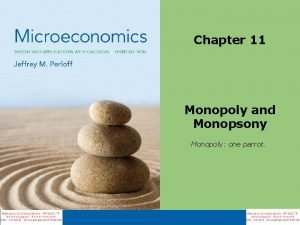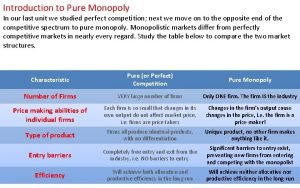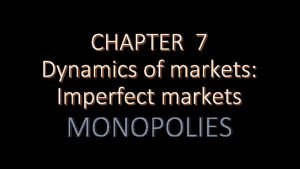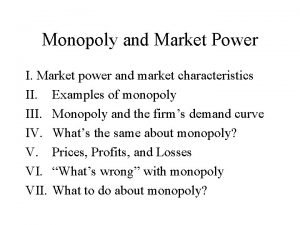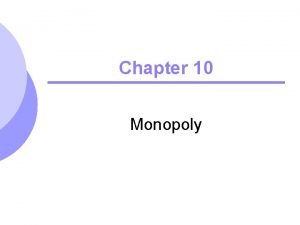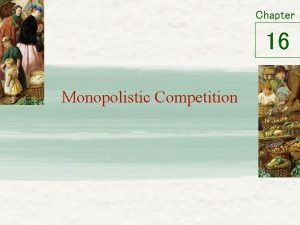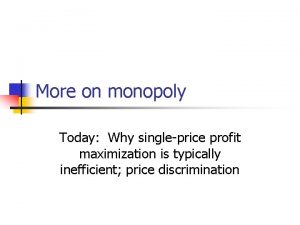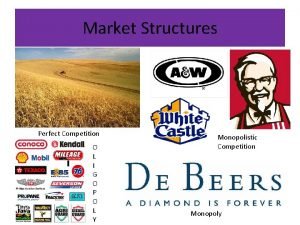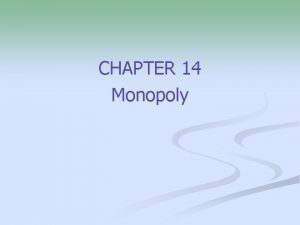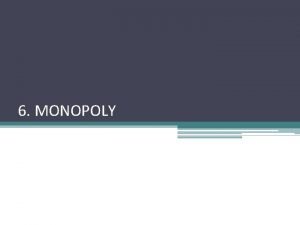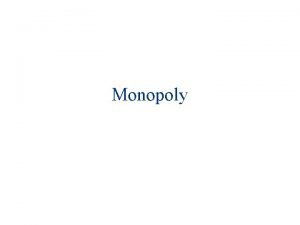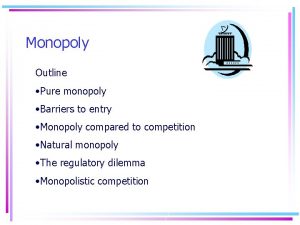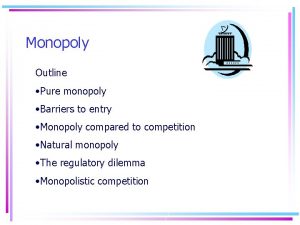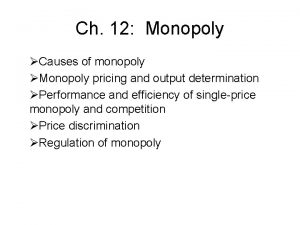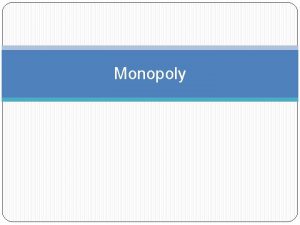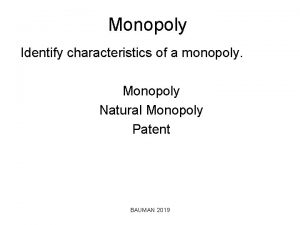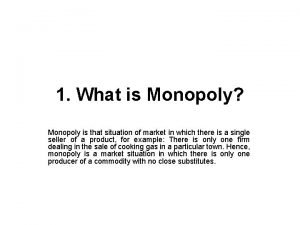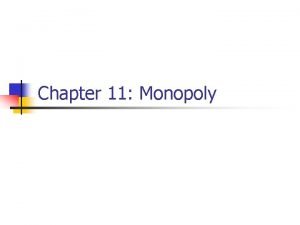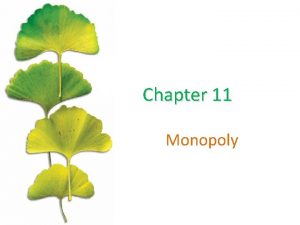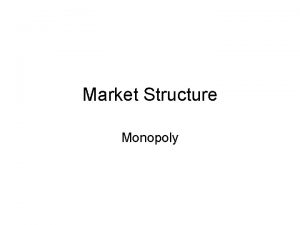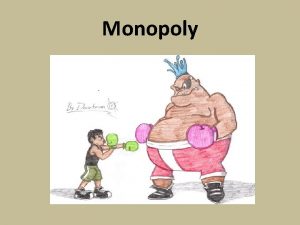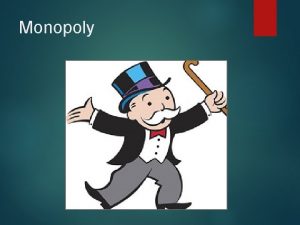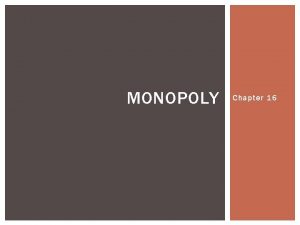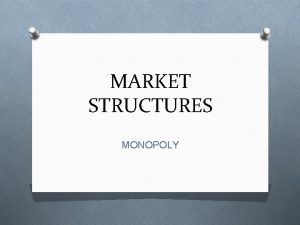Monopoly Monopoly is that situation of market in





















- Slides: 21

Monopoly

Monopoly is that situation of market in which there is a single seller of a product. This situation of market Monopoly , where a single (mono) firm controls (poly) the production of a commodity is called monopoly.

Features of monopoly One seller and large number of buyers-under monopoly there should be a single producer of the commodity. thus, thee is only one firm in monopoly and there is no distinction between firm and industry. Monopoly is also an industry- under monopoly situation , there is only one firm and the difference between firm and industry disappears. There is no difference between the study a firm and industry.

Restriction on the entry of the new firms- Under monopoly , there are some restriction on the entry of new firms into monopoly industry. There is no competitor of a monopoly firm. Full control over price – Being a single of the product a monopolist has full control over its price. A monopolist thus is a price maker. No close substitutes- A monopoly firm produces there is no close substitutes in this market.

Determination of price and equilibrium under monopoly A monopolist is in equilibrium when he produces that amount of output which yield him maximum total profit. Under monopoly, price and equilibrium are determined by two different approaches: 1) Total revenue and total cost analysis 2) Marginal revenue and marginal cost analysis

Total revenue and total cost analysis A firm is in equilibrium at that level of output where difference between TR and TC is maximum. TC is total cost curve and TR, total revenue curve. TR curve begins from point of origin o, TC begins from p. The firm increases its production , total revenue is also increasing. Then , in the beginning total revenue is less than total cost. At point m , total revenue is equal to total cost (TR=TC). Point M is called ‘Break even point. ’ when firm produces more than point M, then its total revenue will be exceeding its total cost (TR>TC). When TP curve will reach its highest point ‘E’ then the firm will be earning maximum profits. This amount OQ)will be called equilibrium output.

COST/REVENUE YY X N M P Q R

Marginal revenue and marginal cost analysis According to this analysis, a monopolist will be in equilibrium when two conditions are fulfilled, i. e. (i) MC=MR and (ii)MC curve cuts MR curve from below. A monopoly earns maximum profit when he is in equilibrium. (ii) In this fig. output is shown on ox-axis and cost /revenue on oy-axis. (iii) Point ‘E’ is an equilibrium point where MC=MR and MC curve cuts MR curve from below.

Y E O X

price determinaton under short period or short-run equilibrium A monopolist will be equilibrium when he produces that amount of output at which (i) marginal cost is equal to marginal revenue and (ii) marginal cost curve cuts marginal revenue curve from below. A monopolist in equilibrium may face any of the three situation in the short-period , viz. , (1)super normal profit ; (2)normal profit ; (3) minimum loss.

Super normal profit If the price (AR) fixed by the monopolist in equilibrium is more than his average cost(AC), then he will get super normal profits. If the price of equilibrium output is more than average cost (AR>AC) then the monopolist will earn super –normal profit. In this figure , the equilibrium at point E, because at this point marginal cost is equal to marginal revenue. The monopolist will produce OQ units of output and sell it at BQ price , which is more than average cost BM by AB per units. (AM-BM=AB). Thus , in this situation the total super normal profit of the monopolist will be BCDP.

Normal profit monopolist will produce OQ units of output and sell it at BQ price , which is more than average cost BM by AB per units. (AMBM=AB). Thus , in this situation the total super normal profit of the monopolist will be BCDP. If the price (AR) fixed by the monopolist in equilibrium is more than his average cost(AC), then he will get super normal profits. If the price of equilibrium output is more than average cost (AR>AC) then the monopolist will earn super –normal profit. In this figure , the equilibrium at point C, because at this point marginal cost is equal to marginal revenue.

Minimum loss In the short run, the monopolist may incur loss also. If in the short-run price falls due to depression or fall in demand. In this figure , the monopolist is in equilibrium at point E, where MC=MR and produces OQ 2 output is fixed OP 1 (FQ 2). The firm will bear total loss equivalent to GFHP 2 as shown by the shaded area.

Determination of long- run or long –run equilibrium In the long –run , the monopolist will be in equilibrium at a point where his long-run marginal cost is equal to marginal revenue (LMC=MR). In this figure , point E indicates the equilibrium of the monopolist. At point E, MR=MC hence OQ =(BQ). BQ being more than long-run average cost CQ (AR>AC), the monopolist will get supernormal profit. The monopolist earns (BQ-CQ=BC) super normal profit per unit. His total super –normal profit will be BCDP as shown by shaded area.


Comparison between monopoly and perfect competition Goals of the firms: A firms ‘s objective , whether operating under perfect competition or monopoly , is to earn maximum profit. A firm that aims at maximizing profit is called a rational firm. Production: under perfect competition it is assumed that all firms produce homogenous products. But monopoly firm not produce homogenous products. Number of sellers and buyers: under perfect competition there are large number of buyers and sellers of homogenous product. On the contrary , under monopoly , there is only one sellers and large number of buyers. Firm is also an industry under monopoly. Shape of demand curve: under perfect competition , due to large number of firms and the assumption of homogenous product , demand curve is perfectly elastic. Under perfect competition , average revenue (AR)curve is equal to marginal revenue(MR). Firm therefore , is a price-taker. On the contrary , under monopoly , average revenue (AR) curve slopes downward. In this case , AR and MR curves are separate from one another as shown in figure , MR curve not only slopes downward, but is below AR curve. Monopolist is the price- maker.

AR=MR

Price and output determination or equilibrium under discriminating monopoly There are two conditions are following: (i) He must get same marginal revenue in both markets. MR 1=MR 2 (i) Equality between MR and MC MR 1=MR 2=MR 3


In this figure(i)marginal cost of total output is equal to combined marginal revenue. (ii) marginal revenue of both markets is equal. (iii) marginal revenue of both markets is equal to marginal cost of total output.

Thank you
 Sau thất bại ở hồ điển triệt
Sau thất bại ở hồ điển triệt Thể thơ truyền thống
Thể thơ truyền thống Con hãy đưa tay khi thấy người vấp ngã
Con hãy đưa tay khi thấy người vấp ngã Thơ thất ngôn tứ tuyệt đường luật
Thơ thất ngôn tứ tuyệt đường luật Tôn thất thuyết là ai
Tôn thất thuyết là ai Phân độ lown ngoại tâm thu
Phân độ lown ngoại tâm thu Chiến lược kinh doanh quốc tế của walmart
Chiến lược kinh doanh quốc tế của walmart Gây tê cơ vuông thắt lưng
Gây tê cơ vuông thắt lưng Block nhĩ thất cấp 1
Block nhĩ thất cấp 1 Tìm độ lớn thật của tam giác abc
Tìm độ lớn thật của tam giác abc Market leader follower challenger nicher
Market leader follower challenger nicher Positioning and targeting
Positioning and targeting Lerner index of monopoly power
Lerner index of monopoly power Monopoly graph
Monopoly graph 7dynamics
7dynamics Features of monopoly market
Features of monopoly market Example of monopoly market
Example of monopoly market Difference between perfect competition and monopoly market
Difference between perfect competition and monopoly market Monopoly graph
Monopoly graph Monopoly profit maximizing price
Monopoly profit maximizing price Characteristics of a monopoly
Characteristics of a monopoly Monopoly and oligopoly examples
Monopoly and oligopoly examples












